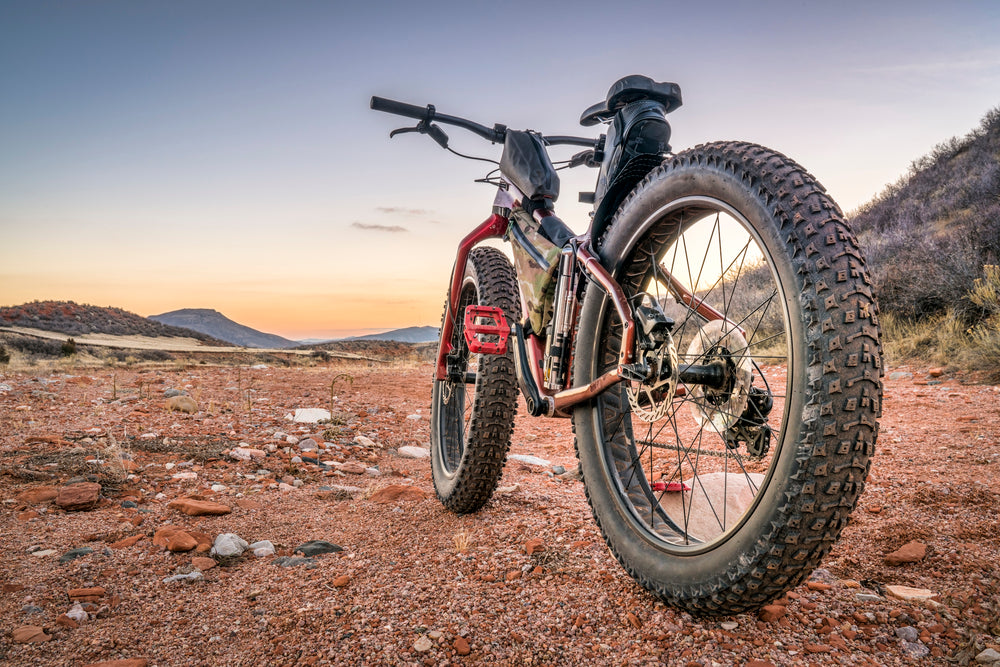
5 Tips On How To Care For Your Fat Tire Bike
If you're the lucky owner of a fat tire bike, then you know just how fun and versatile it can be. These bikes are perfect for riding on snowy or sandy trails, but proper care is essential to keeping your bike in good condition.
In this blog post, we will discuss 5 tips on how to care for your fat tire bike. Plus, we'll also give you a brief and informative overview of how these bikes came to be. You are on a treat today! Let's get started.
1. Keep it clean
Fat bikes are susceptible to dirt and grime, so it's important to keep them clean. Regular washing will help to protect the bike from corrosion and make it easier to ride.
If you want your fat bike to never give you problems, make sure to put it away clean and dry. Clean the rims with a towel especially if you are using rim brakes. Don't forget to wipe down disc rotors as well; they can get grimy from brake pads and snow. Also check the brake pads while you're at it.
2. Lubricate the chain
A properly lubricated chain is essential for any bike, but it's especially important for a fat tire bike. The wider tires put more strain on the drivetrain, so it's crucial to keep the chain well-lubricated.
Bike-specific lubricants are designed to resist being washed away by rain and mud, so they're ideal for use on a fat tire bike. For the wet winter months, it is best to use silicone-based wet lube as opposed to teflon-based dry lube. This is because silicone-based lubricant is thicker and will stick more, while also being resistant to water.
Be sure to apply the lubricant to all sides of the chain, and allow it to penetrate for a few minutes before wiping off any excess. With proper care, your drivetrain will last longer and shifting will be smoother.
3. Inflate the tires
Fat tire bikes need more air than regular tires, so be sure to check the pressure regularly and inflated them to the recommended level. This will help to prevent flats and make your ride more comfortable.
Manufacturers typically recommend a range of pressures for fat tire bikes. The low end of the range is for soft conditions like sand or snow, while the high end is for hard surfaces like pavement. For most riding, you'll want to be somewhere in the middle.
Checking your tire pressure is easy with an air gauge. Just unscrew the valve cap and press the gauge onto the valve stem. You can find a wide variety of gauges at any bike shop. When inflating your tires, use a floor pump with a pressure gauge. This will make it easy to get a perfect pressure.
4. Adjust the brakes
One thing that many people don't realize about fat tire bikes is that their braking performance can be compromised. That's because the wider contact patch of a fat tire can cause brake pads to squeal and grind, which reduces stopping power. What's more, the increased weight of a fat bike can make it harder to bring to a stop.
That's why it's important to regularly check your brakes and adjust them as needed. By keeping your brakes in good working order, you can help to keep yourself safe on the trail. So don't neglect this important maintenance task - your life may depend on it.
5. Don't drain the battery
There are many myths about batteries, but one thing is for sure: you should never ride your fat bike until the battery is completely dead. Doing so can shorten the battery's lifespan and make it less effective.
Instead, try to keep the battery at around 50% charge. This will help to prolong its life and ensure that it's always ready when you need it. If you're not using the bike for a while, it's best to store the battery in a cool, dry place.
The History of Fat Tire Bikes: From Their Inception to Today
Fat tire bikes have been around for over a century, and their popularity is only increasing. In this article, we will explore the history of these unique bicycles. We will discuss how they have evolved over the years and the different applications they are being used for today.
If you are thinking about purchasing a fat tire bike, or if you are just curious about them, then this section is for you!
Timeline: How the Fat Tire Bike Came to Be
Late 1980s - Early Designs & Discovery
Alaskan frame builders were looking for ways to increase the contact patch of their tires on snow, so they began experimenting with custom components and configurations. Steve Baker, with Icycle Bicycles in Anchorage, by welding two rims together and mounting tires side by side, he created a 4.4” wide double-wide tire. Then, he welded a frame to fit the wheels, thus the first fat bike was born.
Simon Rowaker developed the Snowcat, a 1.7” (44mm) wide rim, after seeing Baker's idea. In the early 90s, it became the most popular rim among adventure cyclists because it was wider than any other production rim of that time.
In another part of the world, Ray Molina--an adventure cyclist, tour guide and frame builder--was busy exploring new areas in southern New Mexico. He rode on sand dunes and in arroyos using 2 Snowcat rims that he had welded together to make the first 88mm (3.2”) wide rim. Along with this, he used a 3.5” tire called the Chevron. To accommodate the new equipment, Ray made several frames and tested them at the Samalayuca sand dunes in Chihuahua, Mexico.
1986 - The fat tire bike on Sahara Desert
Way before the latest fat-bike fad, 55-year-old Frenchman Jean Naud rode his three-wheeled bicycle 3200 kilometers across the Sahara Desert from Algiers to Timbuktu.
The Sahara Desert is not only a wasteland of soft sand dunes; it's also full of rocks that can potentially damage bicycle rims. Being an automotive engineer, Jean's solution was to run a bicycle using fat tires. Adding a second driven rear wheel not only improved traction but also helped the bike to float at pressures as low as 7psi. He then devised a hinged subframe which could both raise and disconnect drive from the middle wheel, making it easier to pedal on firmer surfaces or when running lighter loads.
1987- The first Iditabike event challenge
When mountain bikes became a hit in shops in the 1980s, people began customizing them to ride on sand and snow. The 200-mile journey through the Alaskan backcountry was no walk in the park—snowmobile and dog mushing trails had to be carefully followed in winter conditions. Plus, this course just covered the first leg of the historic Iditarod dog mushing trail to Nome; from there, it's another 1000 miles!
The competition was brutal, with a lot of snow on the ground and riders having to walk alongside their bikes. They'll need to make some changes to their equipment if they want to be able to handle next year's challenge. This paved the way for the first major changes and development in fat bike tires for the coming years.
Late 1999 to early 2000 - Interbike convention
Mark Gronewald, the owner of Wildfire Designs Bicycles in Palmer, Alaska, rode one of Molina's prototypes at a demo day Interbike convention in Las Vegas. In late 1999, Gronewald and another Alaskan frame builder, John Evingson, teamed up to design and create several bikes that used Molina's rims and tires. By 2000, Gronewald and Evingson had begun producing their own distinct lines of these types of bikes.
2001 - The term "Fat Bike" was coined
Mark Gronewald organized the import of rims and tires to Alaska, making production runs that were small and handmade. The frames were custom-ordered and designed to accommodate Remolino 80 mm (3.1 in) rims and 3.5-inch (89 mm) tires. Gronewald first worked with Palmer Machinery welding, and eventually contracted frame building to Mike DeSalvo at DeSalvo Cycles of Ashland, Oregon.
His design included an 18 mm (0.71 in) offset wheel to enable full range gearing utilizing standard hubs and bottom brackets available during that time period. Mark Gronewald was the first to coin the term "fat bike" and used it as the model name for his own bikes and sell his works until 2011
2005 - Modern fat bike era
Surly bikes were a game-changer for the fat bike community, making it more accessible and popular than ever before. The Pugsley was defined by its extra-large 65 mm (2.6 in) rims and chunky 3.8-inch (97 mm) Endomorph tires. The Surly Pugsley quickly became a sensation, introducing fat bikes to neighborhood bike shops around the globe. Thus, giving the general public their first glimpse of this new type of bike.
